Steam locomotives of Ireland
A wide variety of steam locomotives have been used on Ireland's railways. This page lists most if not all those that have been used in the Republic of Ireland and Northern Ireland. Irish railways generally followed British practice in locomotive design.
The list that follows is roughly geographic (north to south) order.
Northern Ireland
The Ulster Transport Authority, which controlled the railways in Northern Ireland between 1948 and 1966, replaced steam haulage on passenger trains with diesel multiple units, but had only two diesel shunting locomotives, which meant a continued role for steam on freight work. Twenty-three locomotives passed to Northern Ireland Railways in 1967, but most were not used again and all had been withdrawn by 1971.
Belfast and County Down Railway
The Belfast and County Down Railway was founded in 1848. It absorbed the Belfast, Hollywood and Bangor Railway in 1884 and continued operating until it was nationalised in its centenary year into the Ulster Transport Authority as a result of the Ireland Act 1949.
| Type | Fleet numbers | Quantity made | Manufacturer | Date made | Date withdrawn | Notes [1][2] |
|---|---|---|---|---|---|---|
| 2-2-2 | 1–4 | 4 | Bury, Curtis, and Kennedy | 1848 | 1858–1865 | No. 2 renumbered 8 and rebuilt as 0–4–2; withdrawn 1890s |
| 2-2-2WT | 1T, 2T | 2 | William Fairbairn & Sons | 1850–1851 | 1867–1877 | Renumbered 4 and 5 in 1859 |
| 2-4-0T | 5, 6 | 2 | Beyer, Peacock & Co. | 1857–1858 | 1894–1894 | No. 5 renumbered 7 in 1859 |
| 2-4-0T | 8 | 1 | Beyer, Peacock & Co. | 1859 | 1880s | |
| 0-4-2 | 9, 10 | 2 | William Fairbairn & Sons | 1859 | 1886–1887 | |
| 2-4-0ST | 11–13, 3, 5 | 5+2 | Vulcan Foundry | 1864–67 | 1890–1909 | 12–13 sold to BH&BR 1–2 in 1870; renumbered 15–16, along with two identical locos bought new by BH&BR (3 & 6) → BCDR 17, 20 |
| 2-4-0T | 1 | 1 | John Fowler & Co. | 1867 | 1909 | rebuilt as 0–4–2 in 1884 |
| 2-4-0 | 12, 13 | 2 | Manning Wardle | 1868 | 1888–1904? | |
| 0-6-0 | 14 | 1 | Vulcan Foundry | 1875 | 1904 | |
| 0-6-0 | 4 | 1 | Beyer, Peacock & Co. | 1878 | 1922 | |
| 0-4-2 | 2 | 1 | Sharp, Stewart & Co. | 1880 | 1937 | rebuilt as 0-4-2T in 1902 |
| 0-4-2 | 8 | 1 | BCDR Queens Quay Works, Belfast | 1881 | 1897 | |
| 2-4-0T | 18, 19 | 2 | Yorkshire Engine Co. | 1870 | 1891 | ex BH&BR 4 & 5 |
| 0-4-2 | 10, 9, 13, 16 | 4 | Sharp, Stewart & Co. | 1886–1890 | 1914–1949 | rebuilt as 0–4–2T (1900–1902); 9 renumbered 28 in 1945 |
| 2-4-2T | 18, 19, 21, 22 | 4 | Beyer, Peacock & Co. | 1891 | 1920 | Compounds; rebuilt as 4-4-2T in late 1890s |
| 2-4-0 | 23–25 | 3 | Beyer, Peacock & Co. | 1892 | 1921 | Compounds |
| 0-6-0 | 26 | 1 | Beyer, Peacock & Co. | 1892 | 1950 | |
| 2-4-0 | 6 | 1 | Beyer, Peacock & Co. | 1894 | 1956 | |
| 2-4-2T | 5, 7, 8, 27, 28, 29 | 6 | Beyer, Peacock & Co. | 1896–1897 | 1923–1950 | |
| 4-4-2T | 3, 15, 30, 11, 12, 1, 17, 20, 13, 18, 9, 21 | 12 | Beyer, Peacock & Co. | 1901–1921 | 1956–1962 | UTA renumbered by adding 200 |
| 0-6-0 | 14 | 1 | Beyer, Peacock & Co. | 1904 | 1954 | Renumbered 214 by UTA |
| Railmotor | 1–3 | 3 | Kitson & Co. | 1905–1906 | 1924 | Carriage portions saw further use |
| 0-6-0 | 10, 4 | 2 | Beyer, Peacock & Co. | 1914–1921 | 1956 | 4 renumbered 204 by UTA |
| 4-6-4T | 22–25 | 4 | Beyer, Peacock & Co. | 1920 | 1956 | Renumbered 222–225 by UTA |
| 0-6-4T | 29 | 1 | Beyer, Peacock & Co. | 1923 | 1956 | Renumbered 229 by UTA |
| 4-4-2T | 8, 16, 9 | 3 | Beyer, Peacock & Co. | 1924–1945 | 1956 | UTA renumbered by adding 200 |
| C d | D1 | 1 | Harland & Wolff | 1933 | Renumbered 2 in 1937 | |
| (1A)(A1)d | D2 | 1 | Harland & Wolff | 1937 | Renumbered 28 in 1937 |
Belfast and Northern Counties Railway (1848–1903) & Northern Counties Committee (1903–1949)
The Belfast and Northern Counties Railway (BNCR), was a railway that served the north-east of Ireland. It had its origins in the Belfast and Ballymena Railway that opened to traffic on 11 April 1848. The Northern Counties Committee came into existence on 1 July 1903 as the result of the Midland Railway taking over the BNCR. At the 1923 Grouping the Committee became part of the London Midland and Scottish Railway (LMS); with the nationalisation of the railways in Britain in 1948 the line passed to the British Transport Commission and in the following year, 1949, it was sold to the Ulster Transport Authority (UTA) as a result of the Ireland Act 1949.
- Belfast and Ballymena Railway (1848–1860) and other constituents
The early locomotives of the constituent companies were to assorted designs from a number of manufacturers. The first locomotives for the Belfast and Ballymena Railway were purchased from Bury, Curtis, and Kennedy. These were four 2-2-2 singles and one 0-4-2 goods engine. Later, four more 2-2-2s were ordered but this time from Sharp Brothers. Fairbairn 2-2-2s were to be found on the Ballymena Ballymena, Ballymoney, Coleraine and Portrush Junction Railway but this company also favoured Sharp locomotives which were double framed 2-4-0s.
Belfast and Northern Counties Railway (1860–1903)
The BNCR introduced class letters for its locomotive stock in 1897. The MR (NCC) and later the LMS (NCC) continued to use the system adding new classes as required.
| Class | Type | Fleet numbers | Quantity made | Manufacturer | Date made | Date withdrawn | Notes |
|---|---|---|---|---|---|---|---|
| A | 4-4-0 | 3–5, 9, 17, 20, 34, 63–68 | 13 | York Road Works (7) Derby Works (6) | 1901–1908 | 1929–1936 | Heavy compound locomotives |
| B | 4-4-0 | 24, 59–62 | 5 | Beyer, Peacock & Co. | 1897–1898 | 1924–1932 | Light compound locomotives |
| C | 2-4-0 | 21, 33, 50–52, 56–57 | 7 | Beyer, Peacock & Co. | 1890–1895 | 1926–1942 | Light compound locomotives; 50 renumbered 58 |
| D | 2-4-0 | 50, 55 | 2 | Beyer, Peacock & Co. | 1895 | 1944–1946 | Heavy compound locomotives; named Jubilee and Parkmount; rebuilt as 4-4-0 in 1897 |
| E | 0-6-0 | 53–54 | 2 | Beyer, Peacock & Co. | 1892 | 1934–1944 | Compound goods locomotives |
| F | 2-4-0 | 45–46, 23 | 3 | Beyer, Peacock & Co. | 1880–1885 | 1938–1942 | |
| G | 2-4-0 | 6, 8, 10–11, 22, 27, 29, 40–41 | 9 | Sharp, Stewart & Co. (7) Beyer, Peacock & Co. (2) | 1872–1878 | 1925–1933 | |
| H | 2-4-0 | 12–17 | 6 | Sharp, Stewart & Co. | 1856 | 1908–1924 | |
| I | 2-4-0 | 40–41 | 2 | Beyer, Peacock & Co. | 1868 | 1924 | Renumbered 1–2 |
| J | 2-4-0T | 25, 47–49 | 4 | Beyer, Peacock & Co. | 1883 | 1932–1934 | Rebuilt as saddle tanks |
| K | 0-6-0 | 7, 28, 30–32, 38–39, 43–44 | 9 | Sharp, Stewart & Co. (7) Beyer, Peacock & Co. (2) | 1867–1880 | 1925–1947 | |
| L | 0-6-0 | 18–19, 35 | 3 | Sharp, Stewart & Co. | 1857–1861 | 1925–1933 | |
| L1 | 0-6-0 | 36–37 | 2 | Beyer, Peacock & Co. | 1863 | 1928–1932 | |
| M | 0-4-2 | 26 | 1 | York Road Works | 1873 | 1925 | |
| N | 0-4-0ST | 42 | 1 | Sharp, Stewart & Co. | 1875 | 1925 | |
| O | 0-4-2ST | 60–62 | 3 | Black, Hawthorn & Co | 1874–1875 | 1911–1923 | Narrow gauge locomotives; ex Ballymena, Cushendall and Red Bay Railway 1–3; renumbered 101–103 |
| P | 2-4-0T | 63–64 | 2 | Beyer, Peacock & Co. | 1877–1878 | 1920–1928 | Narrow gauge locomotives; ex Ballymena and Larne Railway 1 & 4; renumbered 104–105 |
| Q | 0-6-0T | 65–67 | 3 | Beyer, Peacock & Co. | 1877–1882 | 1931–1933 | Narrow gauge locomotives; ex Ballymena & Larne Railway 2, 3 & 6; renumbered 106–108 |
| R | 2-6-0ST | 68 | 1 | Beyer, Peacock & Co. | 1880 | 1934 | Narrow gauge locomotive; ex Ballymena & Larne Railway 5; renumbered 109 |
| S | 2-4-2T | 69–70 | 2 | Beyer, Peacock & Co. | 1882 | 1946–1954 | Narrow gauge compound locomotives; renumbered 110–111 |
Northern Counties Committee (1903–1949)
| Class | Type | Fleet numbers | Quantity made | Manufacturer | Date made | Date withdrawn | Notes |
|---|---|---|---|---|---|---|---|
| A1 | 4-4-0 | 3, 4, 9, 17, 34, 64–66, 68 | 9 | (1927–34) | 1947–1954 | Simple rebuilds of class A | |
| B1 | 4-4-0 | 60, 61 | 3 | (1921) | (1932) | Rebuilds of class B | |
| B2 | 4-4-0 | 24 | 1 | (1925) | (1928) | Simple rebuilds of class B | |
| B3 | 4-4-0 | 21, 24, 28, 60, 61 | 5 | (1927–32) | 1938–1947 | Simple rebuilds of classes B1, B2, C and C1 | |
| C1 | 2-4-0 | 21, 51, 52, 57 | 4 | (1926–31) | 1931–1947 | Rebuilds of class C | |
| D1 | 4-4-0 | 50 | 1 | (1926) | 1946 | Rebuild of class D | |
| E1 | 0-6-0 | 53–54 | 2 | (1907–11) | 1934–1944 | Rebuilds of class E | |
| F1 | 2-4-0 | 46 | 1 | (1928) | 1938 | Rebuild of class F | |
| G1 | 2-4-0 | 6, 10, 27 | 3 | (1910–13) | 1931–1933 | Rebuilds of class G | |
| K1 | 0-6-0 | 30, 32, 38–39, 43–44 | 6 | (1909–22) | 1927–1938 | Rebuilds of class K | |
| S | 2-4-2T | 112–113, 103–104 | 4 | York Road Works | 1908–1920 | 1938–1954 | Narrow gauge compound locomotives; 112–113 renumbered 102–101 |
| S1 | 2-4-2T | 101–102 | 2 | (1928–1930) | 1942 | Narrow gauge compound locomotives; rebuilds of class S; renumbered 41–42 | |
| S2 | 2-4-4T | 110 | 1 | (1931) | 1946 | Narrow gauge compound locomotive; rebuild of class S | |
| T | 90–91 | 2 | Derby Works | 1905 | 1913 | Railmotor units | |
| T | 4-4-2T | 113–114 | 2 | Kitson & Co. | 1908 | 1940–1942 | Narrow gauge locomotives; ex Ballycastle Railway 3 & 4 |
| N | 0-4-0ST | 16 | 1 | York Road Works | 1914 | 1951 | |
| U | 4-4-0 | 14–15, 69–70 | 4 | Derby Works | 1914–1922 | 1924–1937 | Renumbered 70–73; rebuilt as class U2 |
| U1 | 4-4-0 | 1–4 | 4 | York Road Works | 1924–1931 | 1946–1949 | Named after Glens |
| U2 | 4-4-0 | 70–87 | 18 | North British Locomotive Co. (7) York Road Works (7+4) | 1924–1936 | 1956–1963 | |
| V | 0-6-0 | 71–73 | 3 | Derby Works | 1923 | 1961–1964 | "renumbered" X–Z; then 13–15 |
| — | ? | 91 | 1 | Sentinel Waggon Works | 1925 | 1932 | |
| W | 2-6-0 | 90–104 | 15 | Derby Works (4) York Road Works (11) | 1933–1942 | 1956–1965 | Most named |
| WT | 2-6-4T | 1–10, 50–57 | 18 | Derby Works | 1946–1950 | 1968–1971 | Nicknamed "Jeeps" |
| X | 0-6-0DH | 17 | 1 | Harland & Wolff | 1936 | 1970 | 330 hp Diesel shunter |
| ? | 0-6-0DM | 22 | 1 | Harland & Wolff | 1934 | ? | 175;hp Diesel shunter; ex War Department 233, né LMS 7057 |
| Y | 0-6-0T | 18–19 | 2 | W. G. Bagnall (1) Hunslet Engine Co. (1) | 1926–1928 | 1956–1963 | Re-gauged LMS Fowler Class 3F; arrived 1944 |
Cross-Border Lines
Following the division of Ireland in 1921 into two administrations, a number of railways now found themselves operating on both sides of the newly created boundary between Northern Ireland and the Irish Free State (later Republic of Ireland).
West Donegal Railway
The 3-foot (914 mm) West Donegal Railway became the Donegal Railway in 1892; and the County Donegal Railways Joint Committee after being jointly acquired in 1906 by the Great Northern Railway (Ireland) and the Midland Railway's Northern Counties Committee.
| Class | Type | Fleet numbers | Quantity made | Manufacturer | Date made | Date withdrawn | Notes [3] |
|---|---|---|---|---|---|---|---|
| 1 | 2-4-0T | 1–3 | 3 | Sharp, Stewart & Co. | 1881 | 1909–1926 | |
| 2 | 4-6-0T | 4–9 | 6 | Neilson & Co. | 1893 | 1931–1937 | |
| 3 | 4-4-4T | 10–11 | 2 | Neilson, Reid & Co. | 1902 | 1933 | |
| 4 | 4-6-4T | 12–15 | 4 | Nasmyth, Wilson & Co. | 1904 | 1953–1959 | Renumbered 9–12 in 1937 |
| 5 | 2-6-4T | 16–20 | 5 | Nasmyth, Wilson & Co. | 1907 | 1940–1950 | Renumbered 4–8 in 1937 |
| 5A | 2-6-4T | 21, 2A, 3A | 3 | Nasmyth, Wilson & Co. | 1912 | 1959 | Renumbered 1–3 in 1937 |
Dundalk, Newry and Greenore Railway
| Class | Type | Fleet numbers | Quantity made | Manufacturer | Date made | Date withdrawn | Notes [4] |
|---|---|---|---|---|---|---|---|
| — | 0-6-0ST | 1–6 | 6 | LNWR Crewe Works | 1873–1898 | 1928–1951 |
Great Northern Railway
The Great Northern Railway (Ireland) (GNRI) was formed in 1876 acquiring a variety of locomotives. Nos 1 to 23 were from Dublin and Drogheda Railway; Nos. 24 to 41 from the Dublin and Belfast Junction Railway; Nos. 43 to circa 78 from the Irish North Western Railway and Londonderry and Enniskillen Railway; Numbers in the eighties from the Newry and Armagh Railway and nos. 100 to 141 from the Ulster Railway.[5] Later acquisitions in the 1880s from the Newry, Warrenpoint, and Rostrevor and the Belfast Central Railway were numbered in the Nineties.[6] The GNRI straddled the border between the Republic and Northern Ireland (after 1921), and so was not incorporated in either the CIÉ or UTA. However, mounting losses saw the network purchased jointly by the Irish and British governments on 1 September 1953. It was run as a joint board, independent of the CIÉ and UTA, until 30 September 1958 when it was dissolved and the remaining stock split equally between the two railways.
- ? (1877–1881)
| Class | Type | Fleet numbers | Quantity made | Manufacturer | Date made | Date withdrawn | Notes |
|---|---|---|---|---|---|---|---|
| B | 0-6-0 | 6, 26–27, 34, 62–63, 65–67 | 9 | Sharp, Stewart & Co. | 1877–1880 | 1925–1938 | |
| G | 2-4-0 | 24–25, 46–47, 59, 80 | 6 | Beyer, Peacock & Co. | 1877–1883 | 1913–1921 | Several renumbered |
| H | 2-4-0 | 84–87 | 4 | Beyer, Peacock & Co. | 1880–1881 | 1931–1932 |
- James Crawford Park (1881–1895)
| Class | Type | Fleet numbers | Quantity made | Manufacturer | Date made | 1958 CIÉ | 1958 UTA | Date withdrawn | Notes |
|---|---|---|---|---|---|---|---|---|---|
| A | 0-6-0 | 28, 31, 33, 79–83, 60–61, 64, 145–146, 149–150 | 15 | Beyer, Peacock & Co. (13) Dundalk Works (2) | 1882–1891 | 3 | 0 | 1937–1961 | Several renumbered; three sold to SL&NCR |
| BT | 4-4-0T | 2–8, 91–92, 97–100 | 13 | Beyer, Peacock & Co. (3) Dundalk Works (10) | 1885–1893 | — | — | 1910–1935 | Several renumbered |
| J | 4-4-0 | 17–21, 45, 48, 115–119 | 12 | Beyer, Peacock & Co. | 1885–1889 | — | — | 1921–1934 | 45/48 renumbered 15/16; two sold to SL&NCR |
| JS | 4-2-2 | 88–89 | 2 | Beyer, Peacock & Co. | 1885 | — | — | 1904 | Named Victoria and Albert |
| P | 4-4-0 | 51–54, 72–73, 82–83 | 8 | Beyer, Peacock & Co. | 1892–1895 | 3 | 0 | 1950–1959 | Rebuilt with superheaters as class Ps |
| AL | 0-6-0 | 29, 32, 36, 55–59, 151–153 | 11 | Beyer, Peacock & Co. (7) Dundalk Works (4) | 1893–1896 | 6 | 2 | 1957–1961 | 151/152 renumbered 141/140 |
| JT | 2-4-2T | 90, 93–94, 95, 13–14 | 6 | Dundalk Works | 1895–1902 | 1 | 0 | 1955–1963 | 13/14 renumbered 91/92 |
- Charles Clifford (1895–1912)
| Class | Type | Fleet numbers | Quantity made | Manufacturer | Date made | 1958 CIÉ | 1958 UTA | Date withdrawn | Notes |
|---|---|---|---|---|---|---|---|---|---|
| PP | 4-4-0 | 12, 25, 42–46, 50, 70–71, 74–77, 106–107, 129 | 17 | Beyer, Peacock & Co. (15) Dundalk Works (2) | 1896–1911 | 5 | 7 | 1957–1963 | Rebuilt with superheaters as class PPs |
| PG | 0-6-0 | 10–11, 78, 100–103 | 7 | Neilson, Reid & Co. (3) Dundalk Works (4) | 1899–1904 | 0 | 7 | 1960–1964 | Rebuilt with superheaters as class PGs |
| Q | 4-4-0 | 120–125, 130–136 | 13 | Neilson, Reid & Co. (9) North British Loco. Co. (2) Beyer, Peacock & Co. (2) | 1899–1904 | 5 | 4 | 1951–1963 | Rebuilt with superheaters as class Qs |
| QG | 0-6-0 | 152–155 | 4 | North British Loco. Co. | 1903–1904 | 4 | 0 | 1962–1963 | Rebuilt with superheaters as class QGs |
| P | 4-4-0 | 88–89, 104–105 | 4 | Dundalk Works | 1904–1906 | 1 | 0 | 1956–1960 | Rebuilt with superheaters as class Ps |
| QL | 4-4-0 | 24, 113–114, 126–128, 156–157 | 8 | North British Loco. Co. (7) Beyer, Peacock & Co. (1) | 1904–1910 | 0 | 3 | 1932–1960 | Rebuilt with superheaters as class QLs |
| QGT | 0-6-2T | 98–99 | 2 | R. Stephenson & Co. | 1905 | 1 | 0 | 1957–1960 | Rebuilt with superheaters as class QGTs |
| LQG | 0-6-0 | 78, 108, 110–111, 158–164 | 11 | North British Loco. Co. (9) Dundalk Works (2) | 1906–1908 | 6 | 5 | 1958–1963 | Rebuilt with superheated as class LQGs |
| RT | 0-6-4T | 22–23, 166–167 | 4 | Beyer, Peacock & Co. | 1908–1911 | 0 | 4 | 1958–1963 | |
| NQG | 0-6-0 | 9, 38–39, 109, 112 | 5 | Nasmyth, Wilson & Co. | 1911 | 2 | 3 | 1958–1963 | Four rebuilt with superheaters as class NQGs; one rebuilt to class LQGs |
| NLQG | 0-6-0 | 165 | 1 | Nasmyth, Wilson & Co. | 1911 | 0 | 1 | 1961 | Rebuilt to class LQGs |
| QGT2 | 0-6-2T | 168–169 | 2 | R. Stephenson & Co. | 1911 | — | — | 1957 | |
| S | 4-4-0 | 170–174 | 5 | Beyer, Peacock & Co. | 1913 | 3 | 2 | 1964–1965 | Named after mountains; CIÉ locos to UTA in 1963 |
| SG | 0-6-0 | 37, 40–41, 137–138 | 5 | Beyer, Peacock & Co. | 1913 | 3 | 2 | 1961–1965 |
- G. T. Glover (1912–1933)
| Class | Type | Fleet numbers | Quantity made | Manufacturer | Date made | 1958 CIÉ | 1958 UTA | Date withdrawn | Notes |
|---|---|---|---|---|---|---|---|---|---|
| T | 4-4-2T | 185–189 | 5 | Beyer, Peacock & Co. | 1913 | 1 | 4 | 1959–1964 | Rebuilt with superheaters as class T1 |
| SG2 | 0-6-0 | 180–184 | 5 | Beyer, Peacock & Co. | 1915 | 3 | 2 | 1961–1963 | |
| S2 | 4-4-0 | 190–192 | 3 | Beyer, Peacock & Co. | 1915 | 1 | 2 | 1960–65 | |
| U | 4-4-0 | 196–200 | 5 | Beyer, Peacock & Co. | 1915 | 3 | 2 | 1959–1963 | Named after Loughs |
| SG3 | 0-6-0 | 6–8, 13–14, 20, 47–49, 96–97, 117–118, 201–202 | 15 | Beyer, Peacock & Co. | 1920–1921 | 7 | 8 | 1960–1967 | 201–202 renumbered 40–41 |
| T2 | 4-4-2T | 1–5 | 5 | Beyer, Peacock & Co. | 1921 | 2 | 3 | 1959–1964 | |
| T2 | 4-4-2T | 21, 30, 115–116, 139, 142–144, 147–148 | 10 | Nasmyth, Wilson & Co. | 1924 | 6 | 4 | 1958–1963 | 147–148 renumbered 67 and 69 |
| SG2 | 0-6-0 | 15–19 | 5 | Nasmyth, Wilson & Co. | 1924–1926 | 2 | 3 | 1959–1965 | |
| Crane | 0-6-0CT | 31 | 1 | Hawthorn Leslie | 1928 | 0 | 0 | 1963 | to Dundalk Engineering Co. (as part of Dundalk Works) in 1958; to CIÉ in 1960 |
| T2 | 4-4-2T | 62–66 | 5 | Beyer, Peacock & Co. | 1929–1930 | 3 | 2 | 1959–1960 | |
| V | 4-4-0 | 83–87 | 5 | Beyer, Peacock & Co. | 1932 | 2 | 3 | 1959–1963 | Three-cylinder compound; named after birds of prey |
- G. B. Howden (1933–1939)
| Class | Type | Fleet numbers | Quantity made | Manufacturer | Date made | 1958 CIÉ | 1958 UTA | Date withdrawn | Notes |
|---|---|---|---|---|---|---|---|---|---|
| UG | 0-6-0 | 78–82 | 5 | Dundalk Works | 1937 | 2 | 3 | 1960–1965 | [7] |
- H. R. McIntosh (1939–1953)
| Class | Type | Fleet numbers | Quantity made | Manufacturer | Date made | 1958 CIÉ | 1958 UTA | Date withdrawn | Notes |
|---|---|---|---|---|---|---|---|---|---|
| UG | 0-6-0 | 145–149 | 5 | Beyer, Peacock & Co. | 1948 | 3 | 2 | 1960–1968 | [7] |
| U | 4-4-0 | 201–205 | 5 | Beyer, Peacock & Co. | 1948 | 2 | 3 | 1962–1965 | Named after counties |
| VS | 4-4-0 | 206–210 | 5 | Beyer, Peacock & Co. | 1948 | 3 | 2 | 1960–1965 | [7] Three-cylinder simple; named after rivers |
Londonderry and Lough Swilly Railway
- Broad gauge locomotives (1862–1882)
| Type | Fleet numbers | Quantity made | Manufacturer | Date made | Date withdrawn | Notes [8] |
|---|---|---|---|---|---|---|
| 0-6-0T | 1–2 | 2 | G&W | 1862 | 1883–1885 | No. 2 renumbered 3; No. 1 sold to Londonderry Port and Harbour Commissioners |
| 0-6-0ST | 3–4 | 2 | Robert Stephenson & Co. | 1864 | 1869–1882 | No. 4 renumbered 2; Sold to Londonderry Port and Harbour Commissioners |
| 0-6-0T | 4–5 | 2 | Sharp, Stewart & Co. | 1876–1879 | 1885 | Sold to Cork and Bandon Railway as their Nos. 14–15 |
- Narrow gauge locomotives (1882–1954)
| Type | Fleet numbers | Quantity made | Manufacturer | Date made | Date withdrawn | Notes [8] |
|---|---|---|---|---|---|---|
| 0-6-2WT | 1 | 1 | Black, Hawthorn & Co | 1882 | 1911 | Sold to a contractor |
| 0-6-2T | 2–3 | 2 | Black, Hawthorn & Co | 1883 | 1912–1913 | |
| 0-6-0T | 4 | 1 | Black, Hawthorn & Co | 1885 | 1940 | renumbered 17 in 1913 |
| 2-4-0T | 5–6 | 2 | Robert Stephenson & Co. | 1874 | 1899 | Ex Glenariff Iron Ore and Harbour Company, acquired 1885; renumbered 5A and 6A in 1899 |
| 4-6-2T | 5–8 | 4 | Hudswell Clarke | 1899–1902 | 1940–1954 | 5 and 6 renumbered 15 and 16 in 1913 |
| 4-6-0T | 1–4 | 4 | Andrew Barclay Sons & Co. | 1902 | 1940–1954 | Owned by the Letterkenny and Burtonport Extension Railway |
| 4-6-2T | 9–10 | 2 | Kerr Stuart | 1904 | 1928–1954 | |
| 4-8-0 | 11–12 | 2 | Hudswell Clarke | 1905 | 1933–1954 | |
| 4-6-2T | 13–14 | 2 | Hawthorn Leslie | 1910 | 1940–1943 | to Letterkenny and Burtonport Extension Railway in exchange for L&BER 5 and 6 |
| 4-8-4T | 5–6 | 2 | Hudswell Clarke | 1912 | 1954 | Owned by the Letterkenny and Burtonport Extension Railway; to L&LSR in exchange for 13 and 14. |
Sligo, Leitrim and Northern Counties Railway
The Sligo, Leitrim and Northern Counties Railway was a small cross-border railway that closed in 1957. Its locomotive fleet never carried numbers, only names.
| Class | Type | Names | Quantity made | Manufacturer | Date made | Date withdrawn | Notes |
|---|---|---|---|---|---|---|---|
| Pioneer | 0-6-2T | Pioneer Sligo | 2 | Avonside Engine Co. | 1877 | 1921 | |
| Leitrim | 0-6-4T | Fermanagh Leitrim Lurganboy Lissadell Hazlewood | 5 | Beyer, Peacock & Co. | 1882–1899 | 1947–1957 | also known as Fermanagh class |
| Erne | 4-4-0T | Erne | 1 | Hudswell Clarke | 1883 | 1910 | rebuilt as 4-4-2T in 1885 |
| Faugh-a-Ballagh | 0-4-0ST | Faugh-a-Ballagh | 1 | Hunslet Engine Co. | 1878 | ? | Acquired 1897: ex contractors' locomotive |
| Waterford | 0-6-0T | Waterford | 1 | Hunslet Engine Co. | 1893 | ? | Acquired 1897: ex contractors' locomotive |
| Sir Henry | 0-6-4T | Sir Henry Enniskillen Lough Gill | 3 | Beyer, Peacock & Co. | 1904–1917 | 1957 | |
| Glencar | 4-4-0 | Blacklion Glencar | (2) | Beyer, Peacock & Co. | 1885–87 | 1928–1931 | Acquired 1921: ex GNRI Class J nos. 118 (Blacklion) and 119 (Glencar) |
| Sligo | 0-6-0 | Glencar ‘A’ Sligo Sligo | (3) | Beyer, Peacock & Co. | 1882–1890 | 1940–1949 | Acquired 1927–1940: ex GNRI Class A nos. 31 (Glencar) and 149 (Sligo); latter swapped for GNRI 69 in 1940 |
| Lough | 0-6-4T | Lough Melvin Lough Erne | 2 | Beyer, Peacock & Co. | 1949 | 1957 | to UTA in 1959 as nos. 26–27, UTA class Z; withdrawn 1968–1970 |
Irish Free State and Republic of Ireland
The railways wholly in the Irish Free State were merged into one private company — Great Southern Railways — in 1925. The GSR renumbered all the broad gauge locomotives into one series with the former Great Southern and Western Railway locomotives retaining their old number. The GSR had two parallel classification systems – a numerical system which was the lowest number of a locomotive in that class, and an alpha-numerical which used a letter to indicate the wheel arrangement, and a number, with the lowest number given to the most powerful class with that wheel arrangement. The latter system was only used by Inchicore Works for accounting purposes, while the former was used by locomotive crews and the drawing office at Inchicore Works.
| Letter | Wheel Arrangement | Letter | Wheel Arrangement | Letter | Wheel Arrangement |
|---|---|---|---|---|---|
| A | 4-8-0T | F | 2-4-2T | K | 2-6-0 |
| B | 4-6-0 | G | 2-4-0 | L | 0-4-2 |
| C | 4-4-2 | H | 0-6-4 | M | 0-4-0 |
| D | 4-4-0 | I | 0-6-2T | N | 2-2-2 |
| E | 0-4-4T | J | 0-6-0 | P | 2-6-2 |
Note that narrow gauge locomotive classes included the letter N after the prefix letter, letter C was also used for Bo-Bo diesels, and that letters B, C, D, F, J, and K were used for the same wheel arrangements by the London and North Eastern Railway, while E and G changed places.
In 1945, the GSR became part of Córas Iompair Éireann (CIÉ), which amalgamated the railway, road transport and canal functions of the State. CIÉ was nationalised in 1950 and settled on a policy of replacing steam with diesel locomotives, a process that was completed in 1962.
Midland Great Western Railway (1847–1924)
- M. Atock (1872–1901)
- MGWR Class D – GSR Class 530 or Class D16
- MGWR Class E – GSR Class 551 or Class J26
- MGWR Class H – GSR Class 619 or Class J6
- MGWR Class K – GSR Class 650 or Class G2
- MGWR Classes L and Lm – GSR Classes 573 and 594, Classes J18 and J19
- MGWR Class Ln – GSR Class 563 or Class J16
- MGWR Class P – GSR Class 614 or Class J10
- MGWR Class W – GSR Class 234 or Class J17
- E. Cusack (1901–1915)
- MGWR Classes A, As and A1 – GSR class 545 or Class D5
- MGWR Class B – GSR Class 646 or Class J2
- MGWR Classes C and Cs – GSR Class 536 or Class D7
- MGWR Classes C and C1 – GSR Class 540 or Class D6
- W. H. Morton (1915–1924)
- MGWR Classes F, Fa, and Fb – GSR Class 623 or Class J5
Great Southern and Western Railway (1845–1924)
- Alexander McDonnell (1864–1883)
- GS&WR Class 2 – GSR Class 2 or Class D19
- GS&WR Class 21 – GSR Class 21 or Class G4
- GS&WR Class 47 – GSR Class 47 or Class E3
- GS&WR Class 90 – GSR Class 90 or Class J30
- GS&WR Class 91 – GSR Class 91 or Class J29
- GS&WR Class 92 – GSR Class 92 or Class H2
- GS&WR Class 101 – GSR Class 101 or Class J15
- GS&WR Class 203 – GSR Class 203 or Class H1
- GS&WR Class 204 – GSR Class 204 or Class J12
- GS&WR Class Sprite – GSR Class Sprite or Classes L4 and L5
- J. A. F. Aspinall (1883–1886)
- GS&WR Class 52 – GSR Class 52 or Class D17
- GS&WR Class 60 – GSR Class 60 or Class D14
- H. A. Ivatt (1886–1896)
- GS&WR Class 33 – GSR Class 33 or Class F6
- GS&WR Class 37 – GSR Class 37 or Class C7
- GS&WR Class 201 – GSR Class 201 or Class J11
- GS&WR Jumbo – GSR Class Jumbo or Class J13
- R. Coey (1896–1911)
- GS&WR Class 27 – GSR Class 27 or Class C4
- GS&WR Class 211 – GSR Class 211 or Class J3
- GS&WR Class 213 – GSR Class 213 or Class I1
- GS&WR Class 301 – GSR Class 301 or Class D11
- GS&WR Class 305 – GSR Class 305 or Class D12
- GS&WR Class 309 – GSR Class 309 or Classes D3 and D10
- GS&WR Class 321 – GSR Class 321 or Classes D2, D3, and D4
- GS&WR Class 333 – GSR Class 333 or Classes D2, D3, D4, and D4a
- GS&WR Class 341 – GSR Class 341 or Class D1
- GS&WR Class 351 – GSR Class 351 or Class J9
- GS&WR Class 355 – GSR Class 355 or Class K3
- GS&WR Class 362 – GSR Class 362 or Class B3 – "Long Toms"
- GS&WR Class 368 – GSR Class 368 or Class K4
- R. E. L. Maunsell (1911–1913)
- GS&WR Class 257 – GSR Class 257 or Class J4
- GS&WR Sambo – GSR Class Sambo or Class L2
- E. A. Watson (1913–1922)
- GS&WR Class 900 – GSR Class 900 or Class A1
- GS&WR 400 Class – GSR Class 400 or Classes B2 & B2a
- J. R. Bazin (1922–1924)
- GS&WR Class 500 – GSR Class 500 or Class B1
Waterford & Limerick Railway
The Waterford and Limerick Railway changed its name to Waterford, Limerick and Western Railway in 1896. It was acquired by the Great Southern and Western Railway in 1900; by which time all but one of its locomotive fleet had been designed by Robinson.
| Type | Fleet numbers | Quantity made | Manufacturer | Date made | GSWR Class | GSWR Nos. | GSR Class | Inchicore Class | Withdrawn | Notes |
|---|---|---|---|---|---|---|---|---|---|---|
| 2-2-2 | WLR 1 to 6 | 6 | Stothert & Slaughter | 1847 | — | — | — | — | 1860–1862 | |
| 2-2-2 | WLR 7 | 1 | ? | ? | — | — | — | — | 1871 | Acquired secondhand from William Dargan in 1853; origin unknown |
| 2-2-2 | WLR 8 to 10 | 3 | Bury, Curtis and Kennedy | 1848–49 | — | — | — | — | 1880–88 | Acquired secondhand from William Dargan in 1850–52; né Newry, Warrenpoint and Rostrevor Railway 1 to 3 (not in order) |
| 2-4-0 | WLR 11 to 12, 17 to 21 | 7 | William Fairbairn & Sons | 1853–55 | 264 | 264 | — | — | 1872–1903 | |
| 0-4-2 | WLR 13 to 16 | 4 | Sharp, Stewart & Co. | 1853–54 | — | — | — | — | 1891–96 | |
| 0-4-2 | WLR 4 to 6 | 3 | Sharp, Stewart & Co. | 1862–64 | 223 | 223 | — | — | 1890–1901 | |
| 2-2-2 | WLR 28 | 1 | Kitson & Co. | 1864 | 280 | 280 | — | — | 1902 | |
| 0-4-0ST | WLR 29 | 1 | Sharp, Stewart & Co. | 1865 | 228 | 228 | 228 | — | 1925 | |
| 0-4-2 | WLR 3 and 7 | 2 | Kitson & Co. | 1876 | — | — | — | — | 1888–92 | |
| 2-4-0 | WLR 25, 31 to 32, 8, 35 to 39 | 10 | Vulcan Foundry | 1874–82 | 281 | 277, 281–283, 261, 285–289 | — | — | 1902–11 | |
| 0-4-2 | WLR 19, 26, 27 and 33 | 4 | Avonside Engine Co. | 1876 | 278 | 272, 278, 284 | — | — | 1899–1910 | |
| 0-6-0T | WLR 34 | 1 | ? | ? | 229 | 229 | — | — | 1901 | Acquired secondhand in 1878 |
| 0-6-0 | WLR 40 and 41 | 2 | Vulcan Foundry | 1883 | 230 | 230–231 | — | — | 1909–10 | |
| 0-6-0WT | WLR 42 | 1 | Hawthorns & Co. (Leith) | 1862 | 232 | 232 | — | — | 1901 | Acquired secondhand in 1883; ex Neath & Brecon Railway No. 3; né Anglesey Central Railway |
| 0-6-0 | WLR 1 | 1 | R. Stephenson & Co. | 1879 | 221 | 221 | — | — | 1909 | Acquired second-hand in 1884; rebuilt as 0-6-0ST in 1899 |
| 4-4-0 | WLR 9 | 1 | Dübs & Co. | 1886 | 262 | 262 | — | — | 1912 | |
| 4-4-0 | WLR 12 | 1 | Vulcan Foundry | 1886 | 265 | 265 | — | — | 1907 | |
| 0-6-0 | WLR 24 | 1 | Dübs & Co. | 1886 | 227 | 227 | — | — | 1910 | |
| Type | Fleet numbers | Quantity made | Manufacturer | Date made | GSWR Class | GSWR Nos. | GSR Class | Inchicore Class | Withdrawn | Notes |
|---|---|---|---|---|---|---|---|---|---|---|
| 0-6-0 | WLR 5 to 7 | 3 | Limerick Works | 1888–93 | 224 | 224 to 226 | — | — | 1905–1909 | |
| 2-4-0 | WLR 10, 22, 20, 23, 43, 44, 47, and 48 | 8 | Dübs & Co. | 1889–94 | 276 | 263, 275, 273, 276, 290 to 293 | 276 | G3 | 1907–1959 | |
| 2-4-2T | WLR 13 and 14 | 2 | Vulcan Foundry | 1891 | 266 | 226 and 227 | 267 491 | F4 F5 | 1933–1935 | 226 sold to CMDR 6 in 1913; to GSR 491 in 1925 |
| 0-4-2T | WLR 3 | 1 | Limerick Works | 1892 | 260 | 260 | — | — | 1912 | |
| 0-6-0 | WLR 45, 46, 49, and 50 | 4 | Dübs & Co. | 1893–95 | 233 | 233 to 236 | 235 | J22 | 1911–1951 | |
| 0-4-4T | WLR 15 | 1 | Limerick Works | 1894 | 268 | 268 | — | — | 1912 | |
| 0-4-4T | WLR 51 and 52 | 2 | Kitson & Co. | 1895 | 294 | 294 and 295 | 295 | E2 | 1910–1954 | |
| 4-4-2T | WLWR 16 to 18, and 21 | 4 | Kitson & Co. | 1896–97 | 269 | 269 to 271, 274 | 269 | C5 | 1949–1957 | |
| 4-4-0 | WLWR 53 to 55 | 3 | Kitson & Co. | 1896–97 | 296 | 296 to 298 | 296 | D15 | 1928–1949 | |
| 0-6-0 | WLWR 56 to 58 | 3 | Kitson & Co. | 1897 | 237 | 237 to 239 | 222 | J25 | 1934–1951 | |
| 0-4-4T | WLWR 27 | 1 | Limerick Works | 1899 | 279 | 279 | 279 | E1 | 1953 | |
| 0-6-0 | WLWR 2, 4, 11 | 3 | Kitson & Co. | 1900 | 222 | 222, | 222 | J25 | 1929–1950 | 4 and 11 sold before delivery to MGWR 141 and 142 |
Dublin and Kingstown Railway
| Type | Class lead | Quantity made | Manufacturer | Date made | GSR Class | Inchicore Class | GSR Nos. | Withdrawn | Notes |
|---|---|---|---|---|---|---|---|---|---|
| 2-2-0[lower-alpha 1] | Vauxhall | 3 | George Forrester and Company | 1834 | — | — | — | — | Dublin, Kingstown & Vauxhall[10][11] - subsequently converted to 2-2-2T |
| 2-2-0 | Hibernia | 3 | Sharp Brothers | 1834 | — | — | — | 1842 | Hibernia, Britania, Manchester[10][11] |
| 2-2-0 | Star | 1 | Horseley Iron Company | 1836 | — | — | — | — | Star[12][11] |
| 2-2-0T[lower-alpha 1] | Victoria | 2 | George Forrester and Company | 1836 | — | — | — | — | Victoria & Comet[12][11] - first tank locomotives in public service subsequently converted to 2-2-2T |
| 2-2-2T | Princess | 5 | Grand Canal Street | 1841 | — | — | — | — | Princess, Belleisle, Shamrock, Erin, Albert[12][11] |
| 2-2-2T | Burgoyne | 4 | Grand Canal Street | 1845 | — | — | — | — | Burgoyne, Cyclops, Vulcan, Jupiter[12] (increased wheelbase)[11] |
Dublin and South Eastern Railway (1853–1924)
The Dublin and South Eastern Railway started out in 1846 as the Waterford, Wexford, Wicklow and Dublin Railway Company. In 1853 it was renamed the Dublin and Wicklow Railway Company, and in 1860 it was renamed the Dublin, Wicklow and Wexford Railway Company and on 31 December 1906 it was renamed again as the Dublin and South Eastern.
- Frederick Pemberton (1854–1856)
- S. W. Haughton (1856-1864)
- William Meikle (1856-1864)
| Type | Fleet numbers | Quantity made | Manufacturer | Date made | GSR Class | Inchicore Class | GSR Nos. | Withdrawn | Notes |
|---|---|---|---|---|---|---|---|---|---|
| 2-2-2WT | D&WR 1 and 2 | 2 | William Fairbairn & Sons | 1853 | — | — | — | 1892–1901 | No. 2 renumbered 45 in 1885 |
| 2-4-0 | D&WR 3 | 1 | William Fairbairn & Sons | 1853 | — | — | — | 1898 | Rebuilt as 2-4-0T in 1884 |
| 2-2-2T | D&WR 4 and 5 | 2 | William Fairbairn & Sons | 1853 | — | — | — | 1872–1900 | No. 5 renumbered 5A in 1897 |
| 2-2-2ST | D&WR 6, 7, 10 and 11 | 4 | Vulcan Foundry | 1854–55 | — | — | — | 1902–03 | Renumbered 6A, 7A, 10A, 11 between 1894 and 1896 |
| 2-4-0ST | D&WR 8 and 9 | 2 | Vulcan Foundry | 1855 | — | — | — | 1890–1903 | Rebuilt as 2-4-0T |
| 2-4-0 | DWWR 12 to 14 | 3 | William Fairbairn & Sons | 1860 | — | — | — | 1902–23 | |
| 0-4-2 | DWWR 15 and 16 | 2 | Sharp, Stewart & Co. | 1860 | — | — | — | 1922–25 | |
| 0-4-2 | DWWR 17 to 23 | 7 | Sharp, Stewart & Co. | 1864 | — | — | — | 1899–1925 | No. 21 rebuilt as 0-4-2T in 1904 |
- J. Wakefield (1865–1882)
| Type | Fleet numbers | Quantity made | Manufacturer | Date made | GSR Class | Inchicore Class | GSR Nos. | Withdrawn | Notes |
|---|---|---|---|---|---|---|---|---|---|
| 2-4-0 | DWWR 24 to 26, 32, and 33 | 5 | Sharp, Stewart & Co. | 1864–73 | 422 | G7 | 422 | 1928 | No. 26 rebuilt as 2-4-0T in 1900 |
| 2-2-2WT | DWWR Ariel et al. | 7 | Neilson & Co. | 1865 | — | — | — | 1886–94 | Ariel, Elfin, Kate Kearney, Kelpie, Oberon, Titania, Banshee.[12][13] Four sold to contractors |
| 2-2-2WT | DWWR 27 and 28 | 2 | Grand Canal Street | 1869 | — | — | — | 1887 | |
| 2-2-2WT | DWWR 29 to 31, 34 to 36, 4, 40 and 27 | 9 | Grand Canal Street (7) Neilson & Co. (2) | 1871–1887 | — | — | — | 1902–23 | 4 renumbered 30 in 1902 |
| 0-4-2 | DWWR 37 to 39 | 3 | Sharp, Stewart & Co. | 1876 | — | — | — | 1923–25 | |
| 2-4-0WT | DWWR 41 | 1 | Grand Canal Street | 1882 | — | — | — | 1925 | rebuilt as 2-4-0T in 1903 |
- W. Wakefield (1882–1894)
| Type | Fleet numbers | Quantity made | Manufacturer | Date made | GSR Class | Inchicore Class | GSR Nos. | Withdrawn | Notes |
|---|---|---|---|---|---|---|---|---|---|
| 2-4-0T | DWWR 42 to 44 | 3 | Beyer, Peacock & Co. | 1883 | — | — | — | 1925 | |
| 2-4-0T | DWWR 1, 2, 6, 7, 9, 10, 28, 45 to 47, and 49 | 11 | Grand Canal Street | 1885–96 | 423 | G1 | 423–426 | 1925–55 | 10, 28, 45, 46 rebuilt as 2-4-2T between 1900 and 1910 |
| 2-4-2T | DWWR 3, 11 | 2 | Grand Canal Street | 1896–98 | 428,430 | F2 | 428 | 1953 | |
| 2-4-2T | DWWR 10, 28, 45, 46 | (4) | (1900–10) | 428 | F2 | 429–433 | 1925–57 | rebuilt from 2-4-0T | |
| 0-6-0 | DWWR 50 and 51 | 2 | Vulcan Foundry | 1891 | 447 | J7 | 447 | 1925–30 | |
| 4-4-2T | DWWR 52 to 54 | 3 | Sharp, Stewart & Co. | 1893 | 458 | C3 | 458–460 | 1953–1960 |
- T. Grierson (1894–1897)
| Type | Fleet numbers | Quantity made | Manufacturer | Date made | GSR Class | Inchicore Class | GSR Nos. | Withdrawn | Notes |
|---|---|---|---|---|---|---|---|---|---|
| 4-4-0 | DWWR 55 to 58 | 4 | Vulcan Foundry | 1895–96 | 450 | D9 | 450–453 | 1929–40 |
- R. Cronin (1897–1917)
| Type | Fleet numbers | Quantity made | Manufacturer | Date made | GSR Class | Inchicore Class | GSR Nos. | Withdrawn | Notes |
|---|---|---|---|---|---|---|---|---|---|
| 0-6-2T | DWWR 4 and 5 | 2 | Kitson & Co. | 1897 | 448 | J1 | 448–449 | 1940–50 | rebuilt as 0-6-0 in 1908 |
| 0-6-0 | DWWR 17 | 1 | Grand Canal Street | 1899 | 440 | J20 | 440 | 1929 | |
| 0-4-2 | DWWR 48 | 1 | Grand Canal Street | 1899 | — | — | — | 1913 | |
| 0-6-0 | DWWR 36 | 1 | Grand Canal Street | 1900 | 441 | J14 | 441 | 1934 | |
| 2-4-2T | DWWR 8, 12, 27, 29, 30, 40 | 6 | Grand Canal Street | 1901–09 | 434 | F1 | 434–439 | 1950–53 | |
| 2-4-2T | DWWR 59 to 64 | 6 | Crewe Works | 1883–96 | 427 | 427 | 1916–36 | ex London and North Western Railway 4-ft 6-in Tanks, acquired 1902 and regauged | |
| 0-6-0 | DWWR 13, 14, 18, 65, and 66 | 5 | Grand Canal Street (3) Beyer, Peacock & Co. (2) | 1905 | 442 | J8 | 442–446 | 1930–1957 | |
| 4-4-0 | DWWR 67 and 68 | 2 | Beyer, Peacock & Co. | 1905 | 454 | D8 | 454 | 1925–1949 | |
| Railmotor | DWWR 1 and 2 | 2 | Manning Wardle | 1906 | — | — | — | (1907) | Rebuilt 1907 as separate 0-4-0T and coach; locos numbered 69–70 |
| 0-4-0T | DSER 69 and 70 | 2 | Manning Wardle | (1907) | Imp | M1 | Elf Imp | 1928–31 | Rebuilt from railmotors 1 and 2; later Class M2 |
| 4-4-2T | DSER 20, 34, and 35 | 3 | Grand Canal Street (1) Beyer, Peacock & Co. (2) | 1911–1924 | 455 | C2 | 455–457 | 1955–59 |
- G. H. Wild (1917–1924)
| Type | Fleet numbers | Quantity made | Manufacturer | Date made | GSR Class | Inchicore Class | GSR Nos. | Withdrawn | Notes |
|---|---|---|---|---|---|---|---|---|---|
| 2-6-0 | DSER 15 and 16 | 2 | Beyer, Peacock & Co. | 1922 | 461 | K2 | 461–462 | 1963–65 |
Cork, Bandon and South Coast Railway (to 1924)
| Type | Fleet numbers | Quantity made | Manufacturer | Date made | GSR Class | Inchicore Class | GSR Nos. | Withdrawn | Notes |
|---|---|---|---|---|---|---|---|---|---|
| 0-2-2WT | 1, 2 | 2 | William Bridges Adams | 1849 | — | — | — | 1867 | |
| 2-2-2 | 3, 4 | 2 | Vulcan Foundry | 1849–1851 | — | — | — | 1889–1890 | |
| 0-4-2 | 5, 6 | 2 | Sharp, Stewart & Co. | 1852 | — | — | — | 1879–1887 | |
| 2-4-0T | 1, 2, 8, 13 and 4A | 5 | Dübs & Co. | 1874–1887 | 482 | G6 | 477, 482 | 1919–1930 | |
| 2-4-0T | 9 and 10 | 2 | J. Cross | 1865 | — | — | — | 1893–1895 | ex West Cork Railways 1 and 2, acquired 1880 |
| 2-4-0ST | 11 | 1 | Vulcan Foundry | 1877 | — | — | — | 1904 | ex West Cork Railways 3, acquired 1880 |
| 0-6-0ST | 5, 6, 12, 16, 17 | 5 | Beyer, Peacock & Co. | 1891–1894 | 472 474 475 | J24 J23 J21 | – | 1925–40 | |
| 0-6-0T | 14, 15 | 2 | Sharp, Stewart & Co. | 1876–1879 | — | — | — | 1908–1910 | ex Londonderry & Lough Swilly Railway 4 and 5, acquired 1885 rebuilt as 4-4-0T between 1893 and 1898 |
| 4-4-0T | 3, 9, 10, 18 | 4 | Dübs & Co. (2) Neilson & Co. (2) | 1891–1894 | 471 479 | C6 | 471 479–481 | 1930–1936 | most rebuilt as 4–4–2T between 1898 and 1902; No. 10 rebuilt as 4-6-0T in 1906 |
| 0-6-2ST | 19, 20 | 2 | Baldwin Locomotive Works | 1900 | — | — | — | 1912–1914 | |
| 4-4-0T | CBSCR 7 | 1 | Cork Works | 1901 | 478 | 478 | 1934 | ||
| 4-6-0T | 4, 8, 11, 13, 14, 15, 19, 20 | 8 | Beyer, Peacock & Co. | 1906–1920 | 463 | B4 | 463–470 | 1945–1961 |
Waterford and Tramore Railway
- WTR Nos. 1 and 2 – GSR Class 483 or N1
- WTR No. 3 – GSR Class 485 or L3
- WTR No. 4 – GSR Class 486 or L1
Cork and Macroom Direct Railway
- CMDR Nos. 2–4 – GSR Class 487 or G5
- CMDR No. 5 – GSR Class 490 or I2
- CMDR No. 6 – GSR Class 491 or F5
Timoleague and Courtmacsherry Light Railway
- TCLR Argadeen – GSR Class K5
- TCLR St. Molaga – GSR Class L6
Cavan and Leitrim Railway (to 1924)
- CLR 1 to 8 — GSR Class 1L or Class DN2
- CLR 9 – GSR Class 9L or HN1
Cork, Blackrock and Passage Railway (to 1924)
- CBPR 1 to 3 – Broad gauge 2-2-2WT
- CBPR 4 to 7 – GSR Class 4P or Class FN1, later Class 10L
Cork and Muskerry Light Railway (to 1924)
- CMLR 1 to 3 – GSR Class 1K or Class DN6
- CMLR 4 and 5 – GSR Class 5K or Class EN1, later Class 6S
- CMLR 7 – GSR Class 7K or DN3
- CMLR 8 – GSR Class 8K or DN7
Schull and Skibbereen Railway (to 1924)
- SSLR 1 to 3 – GSR Class 2S or Class MN1
- SSLR 4 – GSR Class 4S or Class DN5
- SSLR 1 and 3 – GSR Class 1S or Class DN4
Tralee and Dingle Light Railway (to 1924)
- TDLR 1 to 3, 6, and 8 – GSR Class 1T or Class KN2
- TDLR 5 – GSR Class 5T or Class PN2 Currently preserved
- TDLR 7 and 8 – GSR Class 4T or Class KN1
West Clare Railway (to 1924)
- WCR 5 to 7 – GSR Class 5C or Class IN1. No 5 is preserved and operational at the West Clare preserved Railway
- WCR 2, 4, 8, and 9 – GSR Class 2C or Class PN1
- WCR 10 – GSR Class 10C or Class BN1
- WCR 11 – GSR Class 11C or Class BN2
- WCR 1 – GSR Class 1C or Class BN3
- WCR 3 and 7 – GSR Class 3C or Class BN4
Bord Na Mona
- BNM 1/3 WN 2263-2265 Originally numbered 1-3 Renumbered to LM43/45. Extensively upgraded and Modified E Class locomotives from WW1. All 3 survive in Preservation. 1 is now No 7[14] on the Talyllyn. No 2 resides operational on the Stradbally Woodland Railway. No 3 "Shane" now preserved and awaiting overhaul on the Giants Causeway Line.
Great Southern Railways (1925–1944) and Córas Iompair Éireann (from 1945)
The GSR introduced just under sixty steam locomotives between 1925 and 1944,[15]:349 whilst CIÉ introduced one, the experimental Bulleid turf burner. CIÉ did however acquire 83 steam locomotives, which was precisely half of the Great Northern Railway stock, when that company was split between CIÉ and the Ulster Transport Authority after 30 September 1958.[16]:184–185
- J. R. Bazin (1925–1929)
- GSR Class 372 – also Class K1: Numbers 372–391 (R.E.L. Maunsell, imported in 1924)
- GSR Class 280 – also Class M1 (previous Class M1 became Class M2): numbers 280–281
- GSR Class 700 – also Class J15a: Numbers 700–704
- GSR Class 850 – also Class P1: Number 850
- W. H. Morton (1929–1932)
- GSR Class 393 – also Class K1a: Numbers 393–398 (R.E.L. Maunsell, imported in 1924)
- GSR Class 495 – also Class M3: Number 495
- A. W. Harty (1932–1937)
- GSR Class 670 – also Class I3: Numbers 670–674
- GSR Class 710 – also Class J15b: Numbers 710–719
- Edgar Craven Bredin (1937–1942)
- GSR Class 800 – also Class B1a: Numbers 800–802
- M. J. Ginnetty (1942–1944)
- C. F. Tyndall (1944–1951)
- O. V. S Bulleid (1951–1958)
- CIÉ No.CC1 Turf-burning locomotive
Preserved locomotives
See also
- Diesel Locomotives of Ireland
- Multiple Units of Ireland
- Coaching Stock of Ireland
- History of rail transport in Ireland
- Freight Stock of Ireland
References
- Rowledge 1993, pp. 40–42.
- "Locomotives of the Belfast and County Down Railway". The Belfast & County Down Railway Museum Trust. Retrieved 4 June 2013.
- Rowledge 1993, pp. 116–118.
- Rowledge 1993, p. 118.
- Ahrons (1954), pp. 66–80.
- Ahrons (1954), p. 69.
- Rowledge 1993, pp. 37, 56, 114.
- Rowledge 1993, pp. 115.
- Haresnape & Rowledge (1982), pp. 17–27
- Kullman, Kurt (28 May 2018). "Rolling Stock". "The First Irish Railway: Westland Row to Kingstown". THP Ireland. p. 45. ISBN 978-0750987646.
- Murray, K. A. (1981). "10 — Locomotives". Ireland's First Railway. Irish Railway Record Society. ISBN 0904078078.
- "Dublin's First Railway". Dublin Historical Record. 1 (2): 36−37. JSTOR 30080094.
- Shepherd, Ernie (1988). The Dublin & South Eastern Railway (1988 ed.). Midland Publishing Ltd. p. 140,199,202. ISBN 1 85780 082 6.
- Tom Rolt
- Clements, Jeremy; McMahon, Michael (2008). Locomotives of the GSR. Colourpoint Books. ISBN 9781906578268.
- Baker, Michael H. C. (1972). "Irish railways since 1916". Ian Allan. ISBN 0711002827.
- "NO.3BG "GUINNESS"". RPSI. Retrieved 22 April 2019.
Sources
- Ahrons, E. L. (1954). L. L. Asher (ed.). Locomotive and train working in the latter part of the nineteenth century. six. W Heffer & Sons Ltd.
- Clements, Jeremy & McMahon, Michael (2008). Locomotives of the GSR. Newtownards: Colourpoint Books. ISBN 978-1-906578-26-8.
- Haresnape, Brian; Rowledge, Peter (1982). Robinson Locomotives, a pictorial history. Shepperton, Surrey: Ian Allan Limited. ISBN 0-7110-1151-6.
- Rowledge, J. W. P. (1993). Irish Steam Locomotive Register. Stockport, Merseyside: Irish Traction Group. ISBN 0-947773-33-9.
External links
| Wikimedia Commons has media related to Steam locomotives of Ireland. |





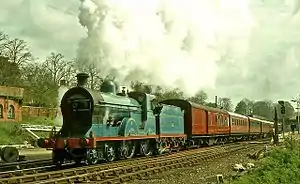


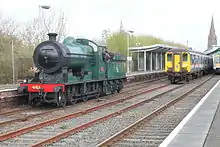
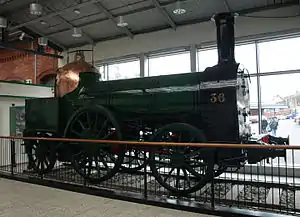
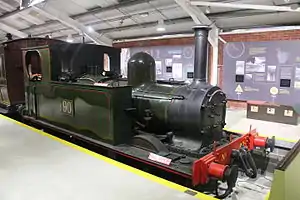
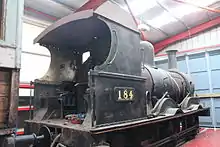
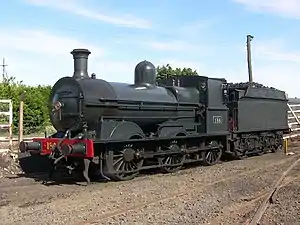


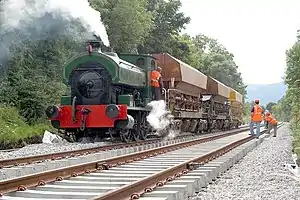




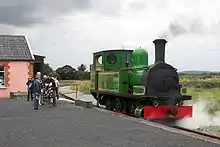


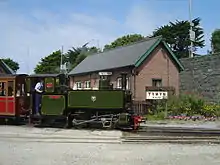
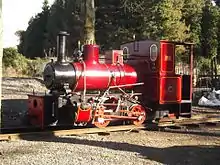

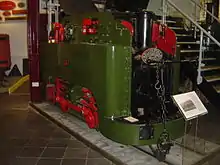
.jpg.webp)